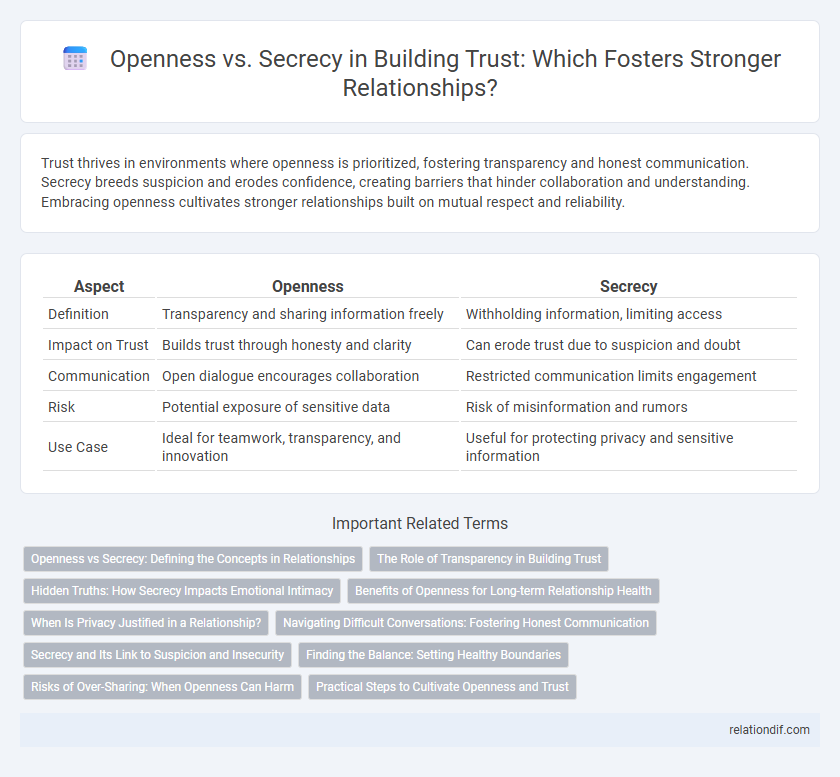Trust thrives in environments where openness is prioritized, fostering transparency and honest communication. Secrecy breeds suspicion and erodes confidence, creating barriers that hinder collaboration and understanding. Embracing openness cultivates stronger relationships built on mutual respect and reliability.
Table of Comparison
| Aspect | Openness | Secrecy |
|---|---|---|
| Definition | Transparency and sharing information freely | Withholding information, limiting access |
| Impact on Trust | Builds trust through honesty and clarity | Can erode trust due to suspicion and doubt |
| Communication | Open dialogue encourages collaboration | Restricted communication limits engagement |
| Risk | Potential exposure of sensitive data | Risk of misinformation and rumors |
| Use Case | Ideal for teamwork, transparency, and innovation | Useful for protecting privacy and sensitive information |
Openness vs Secrecy: Defining the Concepts in Relationships
Openness in relationships involves transparent communication, sharing thoughts, feelings, and intentions honestly to build trust and emotional intimacy. Secrecy, by contrast, implies withholding information or feelings, which can create barriers, suspicion, and mistrust between partners. Balancing openness with appropriate privacy is essential to nurture mutual respect and maintain a healthy bond.
The Role of Transparency in Building Trust
Transparency plays a crucial role in building trust by fostering openness and accountability between parties. Clear communication and the sharing of relevant information reduce uncertainty and demonstrate integrity. Organizations that prioritize transparency cultivate stronger relationships and long-term loyalty from stakeholders.
Hidden Truths: How Secrecy Impacts Emotional Intimacy
Secrecy often breeds hidden truths that erode emotional intimacy by creating barriers to authentic communication and vulnerability. When individuals withhold information, it fosters suspicion and reduces trust, causing emotional distance in relationships. Openness, in contrast, promotes transparency and mutual understanding, strengthening trust and deepening emotional connections.
Benefits of Openness for Long-term Relationship Health
Openness fosters transparency, which strengthens trust by creating an environment where individuals feel safe to share thoughts and feelings without fear of judgment. This transparency enhances communication and reduces misunderstandings, leading to more resilient and lasting relationships. Over time, openness cultivates emotional intimacy and mutual respect, essential components for sustained relationship health.
When Is Privacy Justified in a Relationship?
Privacy is justified in a relationship when it safeguards personal boundaries and fosters individual autonomy without eroding mutual trust. Openness should be balanced by respecting each partner's need for confidential thoughts, sensitive information, or past experiences that may not be immediately shareable. Establishing clear communication about privacy expectations helps maintain trust while honoring both openness and discretion.
Navigating Difficult Conversations: Fostering Honest Communication
Navigating difficult conversations requires fostering honest communication by prioritizing openness to build trust and understanding. Transparent dialogue encourages vulnerability and reduces misunderstandings, enabling constructive resolution of conflicts. Emphasizing empathy and active listening supports a culture where honesty thrives despite challenges, strengthening relational bonds.
Secrecy and Its Link to Suspicion and Insecurity
Secrecy often breeds suspicion by creating information gaps that foster doubt and mistrust among individuals or groups. When critical details are withheld, it triggers insecurity, leading people to speculate and assume the worst. This cycle undermines relationships and erodes trust, as transparency becomes compromised in favor of concealment.
Finding the Balance: Setting Healthy Boundaries
Establishing trust requires a careful balance between openness and secrecy, where sharing relevant information fosters transparency without compromising privacy. Setting healthy boundaries involves clearly defining what information is shared and what remains confidential to protect personal integrity and mutual respect. This equilibrium ensures relationships are built on genuine understanding while safeguarding individual autonomy.
Risks of Over-Sharing: When Openness Can Harm
Excessive openness risks exposing sensitive information, leading to breaches in privacy and trust erosion. Over-sharing personal or organizational details can result in security vulnerabilities and exploitation by malicious actors. Balancing transparency with discretion is essential to protect reputations and maintain secure, trustworthy relationships.
Practical Steps to Cultivate Openness and Trust
Encouraging transparent communication by sharing relevant information promptly fosters trust and reduces misunderstandings. Establishing clear expectations and creating safe environments where team members feel comfortable expressing ideas and concerns enhances openness. Regular feedback loops and active listening practices solidify mutual respect and commitment, reinforcing a culture of trust.
Openness vs Secrecy Infographic

 relationdif.com
relationdif.com